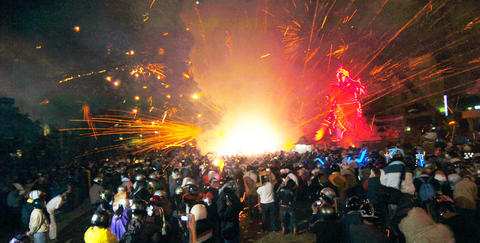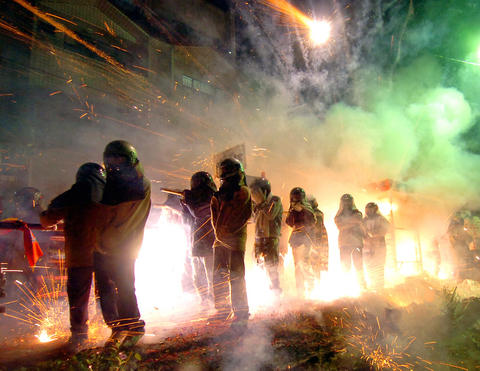The actual Lunar New Year holiday is a time for families, and it is not until the Lantern Festival that the truly celebratory aspect of the festival becomes apparent. Local governments have gone all out to put on a show, and the events taking place in Taipei and Kaohsiung this weekend are likely to be spectacular. If that's not enough, the "Taiwan" lantern festival, sponsored by the Taiwan Tourism Bureau, will be stirring up a storm in Tainan next weekend. Apart from displays of lanterns, for those looking for greater excitement, there is the delightful spectacle presented by the Pingsi International Lantern Festival (台北縣平溪國祭天燈節), as well as the more energetic celebrations of Taitung's Bombing of Master Han Dan (炸寒單) and Yenshui's Beehive Firecracker Festival (鹽水蜂炮).
Each city and organizing body has tried to put its own special stamp on its lantern festival.
This year, in a departure from the aggressively modern designs that have characterized Taipei's previous lantern festival, designer Liu Kuo-chang (劉國滄) has sought to integrate tradition into a playfully modern design built out of 1,000 mouse-shaped balloons. The whole thing is based on the traditional New Year's tale of the Wedding of the Mice. For those unfamiliar with the story, it will be presented by the Taiyuan Puppet Theater Company (台原偶戲團) before the steps of the Sun Yat-sen Memorial Hall. The lantern itself stands four-stories high, and its appearance of a Chinese paper-cut ball has a nicely festive feel. Inside, it is packed with LED lights, which the city government says will conserve electricity.

PHOTO: TAIPEI CITY GOVERNMENT
With a focus on sport and the upcoming 2008 Beijing Olympics, Kaohsiung has forgotten about the mice altogether. The enormous torch that has sprung up in the middle of the Ai River (愛河), though it's supposed to look like a bunch of flowers during the day, cannot really be mistaken for anything other than the Olympic flame. It stands 18m high and weighs 18 tonnes. Kaohsiung will be aiming to impress with its high altitude fireworks, a first this year, and the light and water show with music specially composed by Grammy award-winning artist Jamii Szmadzinski. Whatever one might think of this Olympic mania, it seems somewhat preferable to Taichung's Micky Mouse affair. The city government will be giving away 300,000 Micky Mouse lanterns for the event.

PHOTOS: TAIPEI TIMES AND COURTESY OF THE TAIPEI CITY GOVERNMENT

PHOTOS: TAIPEI TIMES AND COURTESY OF THE TAIPEI CITY GOVERNMENT

PHOTOS: TAIPEI TIMES AND COURTESY OF THE TAIPEI CITY GOVERNMENT

PHOTOS: TAIPEI TIMES AND COURTESY OF THE TAIPEI CITY GOVERNMENT

PHOTOS: TAIPEI TIMES AND COURTESY OF THE TAIPEI CITY GOVERNMENT

Dec. 16 to Dec. 22 Growing up in the 1930s, Huang Lin Yu-feng (黃林玉鳳) often used the “fragrance machine” at Ximen Market (西門市場) so that she could go shopping while smelling nice. The contraption, about the size of a photo booth, sprayed perfume for a coin or two and was one of the trendy bazaar’s cutting-edge features. Known today as the Red House (西門紅樓), the market also boasted the coldest fridges, and offered delivery service late into the night during peak summer hours. The most fashionable goods from Japan, Europe and the US were found here, and it buzzed with activity

During the Japanese colonial era, remote mountain villages were almost exclusively populated by indigenous residents. Deep in the mountains of Chiayi County, however, was a settlement of Hakka families who braved the harsh living conditions and relative isolation to eke out a living processing camphor. As the industry declined, the village’s homes and offices were abandoned one by one, leaving us with a glimpse of a lifestyle that no longer exists. Even today, it takes between four and six hours to walk in to Baisyue Village (白雪村), and the village is so far up in the Chiayi mountains that it’s actually

These days, CJ Chen (陳崇仁) can be found driving a taxi in and around Hualien. As a way to earn a living, it’s not his first choice. He’d rather be taking tourists to the region’s attractions, but after a 7.4-magnitude earthquake struck the region on April 3, demand for driver-guides collapsed. In the eight months since the quake, the number of overseas tourists visiting Hualien has declined by “at least 90 percent, because most of them come for Taroko Gorge, not for the east coast or the East Longitudinal Valley,” he says. Chen estimates the drop in domestic sightseers after the

US Indo-Pacific Commander Admiral Samuel Paparo, speaking at the Reagan Defense Forum last week, said the US is confident it can defeat the People’s Republic of China (PRC) in the Pacific, though its advantage is shrinking. Paparo warned that the PRC might launch a “war of necessity” even if it thinks it could not win, a wise observation. As I write, the PRC is carrying out naval and air exercises off its coast that are aimed at Taiwan and other nations threatened by PRC expansionism. A local defense official said that China’s military activity on Monday formed two “walls” east